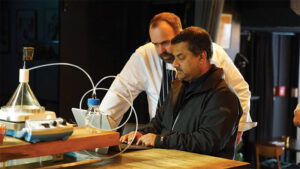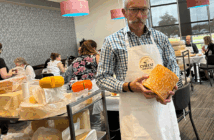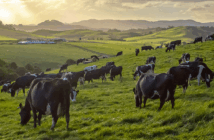
Working with world-class development chef Dale Bowie, the scientists are analysing biochemical changes in beef steak during the cooking process. When being cooked, the steak releases compounds emitted as gases called volatiles, which can be captured and analysed. These volatiles, among other factors such as texture and colour, help determine the eating quality of the steak.
Dale Bowie says this kind of science is invaluable to chefs and the food industry.
“Understanding the science of flavour and protein reactions at a molecular level allows chefs to showcase the full potential of meat.”
Scientists Santanu Deb-Choudhury and Arvind Subbaraj studied the volatiles produced at a range of different core temperatures from cooking steak using technology called Direct Analysis in Real Time Mass Spectrometry (DART-MS).
“The results look promising, and there is a clear difference in the volatile profile at different temperatures. This information can help pick the temperature ‘sweet spot’, thus providing a better eating experience.
“It is such a new thing that we are still validating it with the development chefs. The AI make certain ingredient pairings based on the chemical composition, but then we need the validation from the chefs to see if it really tastes good,” says Deb-Choudhury.
This technology will also be utilised for other purposes as well he says.
“We have started compiling a massive number of recipes in the database – over 50,000 – and the ingredients that go into them. The technology looks at the composition of the ingredients. Once we know the composition of the ingredients and the ones they are matched with in a recipe, it helps us understand how these flavour pairings can be used. For example, if we haven’t thought of certain ingredients that can work together in a recipe before, now we have the technology to understand if they are compatible.”
The AI can not only be used for food served straight to a consumer in a hospitality setting but also in the manufacturing process.
“New types of food are being manufactured based on information we are gathering from AI.”
And what’s next for this innovative new project? Investigating new uses for native ingredients is high on the agenda as well as research into offal.
“We are still building on the flavour database of this AI system, augmenting it and integrating flavour from native ingredients. We are trying to see whether native ingredients can be used in unique ways combined with more traditional ingredients.
“We are also looking at offal quite closely because offal is unpopular with many people. If we can use AI to understand the composition of offal with other ingredients to provide nice tasting food, then that could increase value from low-value streams from the meat industry. It would also mean we are utilising the carcass to the best of our abilities and reducing wastage.”
Deb-Choudhury says the team are also trying to add in some constraints to the system so users can opt out of certain ingredients such as dairy.
“The AI will provide them with combinations or recipe ideas without the ingredients they have specified they don’t want in their diet.”




























































































